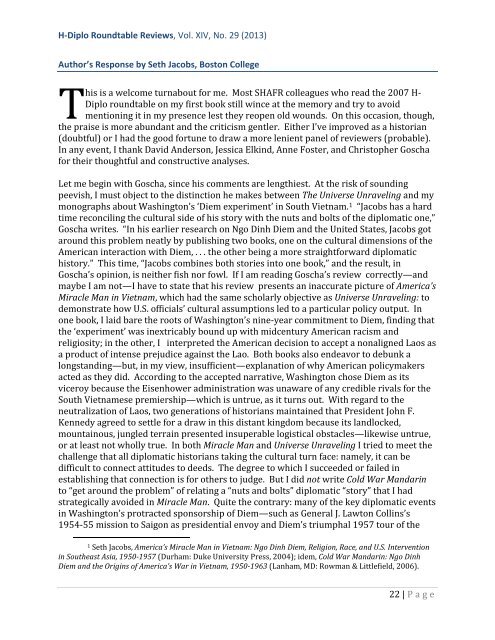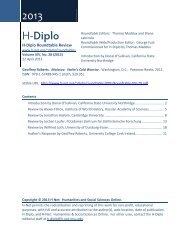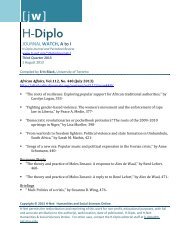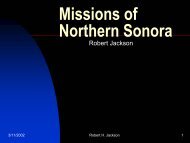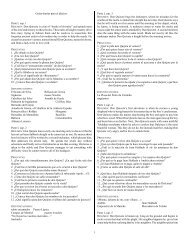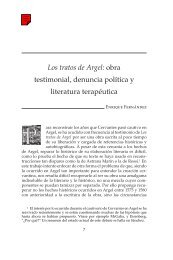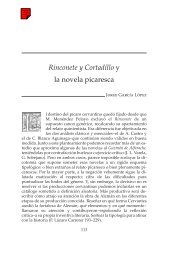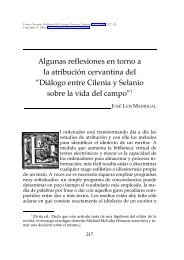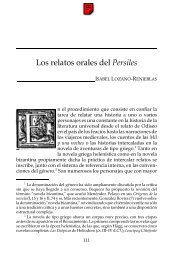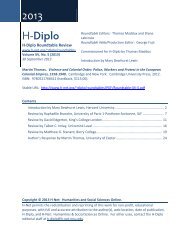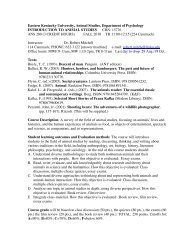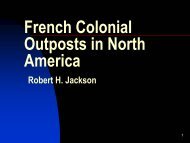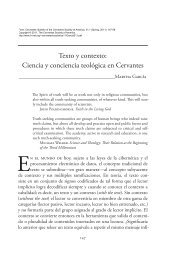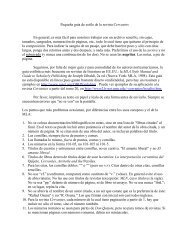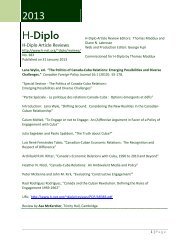H-Diplo Roundtables, Vol. XIV, No. 29 (2013) - H-Net
H-Diplo Roundtables, Vol. XIV, No. 29 (2013) - H-Net
H-Diplo Roundtables, Vol. XIV, No. 29 (2013) - H-Net
You also want an ePaper? Increase the reach of your titles
YUMPU automatically turns print PDFs into web optimized ePapers that Google loves.
H-<strong>Diplo</strong> Roundtable Reviews, <strong>Vol</strong>. <strong>XIV</strong>, <strong>No</strong>. <strong>29</strong> (<strong>2013</strong>)<br />
Author’s Response by Seth Jacobs, Boston College<br />
T<br />
his is a welcome turnabout for me. Most SHAFR colleagues who read the 2007 H-<br />
<strong>Diplo</strong> roundtable on my first book still wince at the memory and try to avoid<br />
mentioning it in my presence lest they reopen old wounds. On this occasion, though,<br />
the praise is more abundant and the criticism gentler. Either I’ve improved as a historian<br />
(doubtful) or I had the good fortune to draw a more lenient panel of reviewers (probable).<br />
In any event, I thank David Anderson, Jessica Elkind, Anne Foster, and Christopher Goscha<br />
for their thoughtful and constructive analyses.<br />
Let me begin with Goscha, since his comments are lengthiest. At the risk of sounding<br />
peevish, I must object to the distinction he makes between The Universe Unraveling and my<br />
monographs about Washington’s ‘Diem experiment’ in South Vietnam. 1 “Jacobs has a hard<br />
time reconciling the cultural side of his story with the nuts and bolts of the diplomatic one,”<br />
Goscha writes. “In his earlier research on Ngo Dinh Diem and the United States, Jacobs got<br />
around this problem neatly by publishing two books, one on the cultural dimensions of the<br />
American interaction with Diem, . . . the other being a more straightforward diplomatic<br />
history.” This time, “Jacobs combines both stories into one book,” and the result, in<br />
Goscha’s opinion, is neither fish nor fowl. If I am reading Goscha’s review correctly—and<br />
maybe I am not—I have to state that his review presents an inaccurate picture of America’s<br />
Miracle Man in Vietnam, which had the same scholarly objective as Universe Unraveling: to<br />
demonstrate how U.S. officials’ cultural assumptions led to a particular policy output. In<br />
one book, I laid bare the roots of Washington’s nine-year commitment to Diem, finding that<br />
the ‘experiment’ was inextricably bound up with midcentury American racism and<br />
religiosity; in the other, I interpreted the American decision to accept a nonaligned Laos as<br />
a product of intense prejudice against the Lao. Both books also endeavor to debunk a<br />
longstanding—but, in my view, insufficient—explanation of why American policymakers<br />
acted as they did. According to the accepted narrative, Washington chose Diem as its<br />
viceroy because the Eisenhower administration was unaware of any credible rivals for the<br />
South Vietnamese premiership—which is untrue, as it turns out. With regard to the<br />
neutralization of Laos, two generations of historians maintained that President John F.<br />
Kennedy agreed to settle for a draw in this distant kingdom because its landlocked,<br />
mountainous, jungled terrain presented insuperable logistical obstacles—likewise untrue,<br />
or at least not wholly true. In both Miracle Man and Universe Unraveling I tried to meet the<br />
challenge that all diplomatic historians taking the cultural turn face: namely, it can be<br />
difficult to connect attitudes to deeds. The degree to which I succeeded or failed in<br />
establishing that connection is for others to judge. But I did not write Cold War Mandarin<br />
to “get around the problem” of relating a “nuts and bolts” diplomatic “story” that I had<br />
strategically avoided in Miracle Man. Quite the contrary: many of the key diplomatic events<br />
in Washington’s protracted sponsorship of Diem—such as General J. Lawton Collins’s<br />
1954-55 mission to Saigon as presidential envoy and Diem’s triumphal 1957 tour of the<br />
1 Seth Jacobs, America’s Miracle Man in Vietnam: Ngo Dinh Diem, Religion, Race, and U.S. Intervention<br />
in Southeast Asia, 1950-1957 (Durham: Duke University Press, 2004); idem, Cold War Mandarin: Ngo Dinh<br />
Diem and the Origins of America’s War in Vietnam, 1950-1963 (Lanham, MD: Rowman & Littlefield, 2006).<br />
22 | P age


